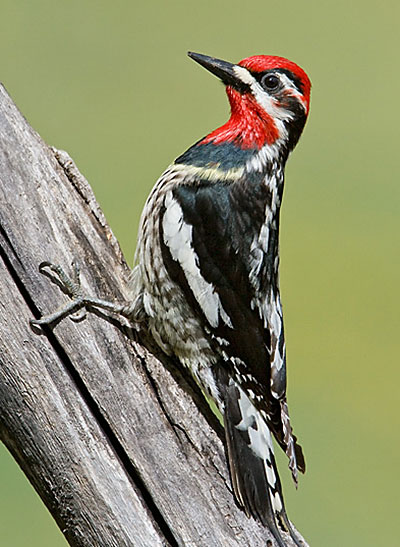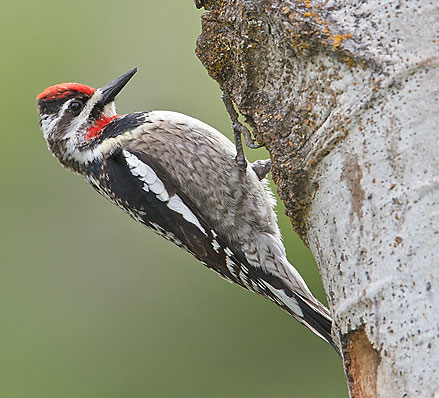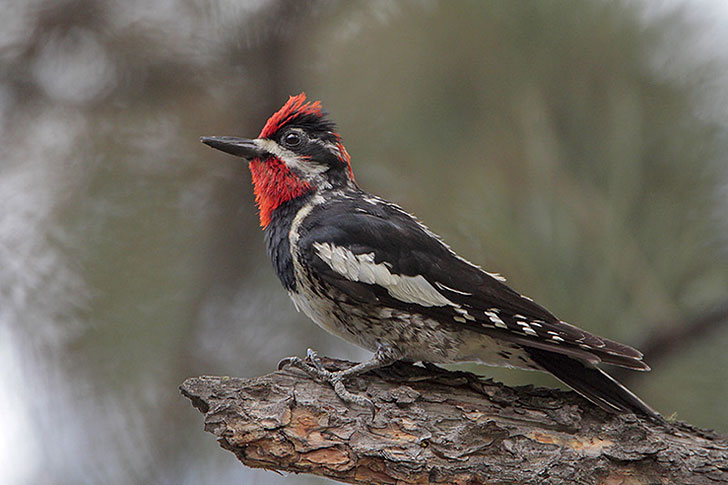Occurring in the interior of Western North America, the Red-naped Sapsucker is related to the Red-breasted and Yellow-bellied Sapsuckers with which it was formerly considered to be the same species. All three species are named for the many small holes they drill into sap producing trees. Red-naped and Red-breasted Sapsuckers are known to hybridize occasionally.
Studies in different parts of the Red-naped Sapsucker’s range have shown territory sizes ranging from 4 to 32 acres. Nest trees are reused from one year to the next, but not nest cavities. Broods fledge from the nest over a period ranging from one to three days.
On this page
Description of the Red-naped Sapsucker
BREEDING MALE
The Red-naped Sapsucker is a medium woodpecker with a red crown and nape, black and white stripes on the face, a mostly red throat, black wings with a large vertical white wing bar, black breast and yellowish underparts, and a black back heavily covered with two rows of white markings.
The sexes are largely similar, though males have a red chin.

Male. © Glenn Bartley
Female
The sexes are largely similar, though females usually have a white chin.
Seasonal change in appearance
None.
Juvenile
Juveniles have brownish heads and breasts.
Habitat
Red-naped Sapsuckers inhabit mountainous, mixed coniferous and deciduous forests.
Diet
Red-naped Sapsuckers eat insects, tree sap, and fruit.

Female. © Glenn Bartley
Behavior
Red-naped Sapsuckers forage by drilling sap wells in tree bark, as well as by gleaning insects from trees, or by harvesting berries.
Range
Red-naped Sapsuckers breed in Rocky Mountain and Great Basin regions of the western U.S. They winter in the southwestern U.S. and in Mexico. The population appears to be stable.
Fun Facts
It was only in the 1980s that the Red-breasted Sapsucker, Red-naped Sapsucker, and Yellow-bellied Sapsucker were split into three species.
Red-naped Sapsuckers and Red-breasted Sapsuckers hybridize where their ranges overlap.
Vocalizations
Calls include a nasal squeal or a loud “qheeah”.
Similar Species
- Red-breasted Sapsuckers lack black on the breast and have mostly red heads. Yellow-bellied Sapsuckers have throats completely outlined in black, and usually have white napes.
Nesting
The Red-naped Sapsucker’s nest is in an excavated tree cavity.
Number: Usually lay 4-7 eggs.
Color: White.
Incubation and fledging:
The young hatch at about 11-14 days, and begin to fly in about another 3-4 weeks, though continuing to associate with the adults for some time.
Bent Life History of the Red-naped Sapsucker
Published by the Smithsonian Institution between the 1920s and the 1950s, the Bent life history series of monographs provide an often colorful description of the birds of North America. Arthur Cleveland Bent was the lead author for the series. The Bent series is a great resource and often includes quotes from early American Ornithologists, including Audubon, Townsend, Wilson, Sutton and many others.
Bent Life History for the Red-naped Sapsucker – the common name and sub-species reflect the nomenclature in use at the time the description was written.
SPRYRAPICUS VARIUS NUCHALIS Baird
The western race of the eastern yellow-bellied sapsucker occupies an extensive range in the general region of the Rocky Mountains, chiefly east of the Sierra Nevada and Cascade Ranges, from central British Columbia and Alberta to western Texas and Arizona.
Ridgway (1914) gives a full description of this form, which is worth quoting in view of his remarks as to its status; he describes it as: Similar to S. v. varies, but with much less white on back, this forming two definite but broken stripes, converging posteriorly; nape always with more or less of red, under parts less strongly tinged with yellow, and wing and tail averaging decidedly longer; adult male with red of throat more extended, both laterally and posteriorly, covering malar region (except anterior portion), where meeting white sub-auricular stripe; adult female with at least lower half of throat red (sometimes whole throat red, only the chin being white) ; young much darker above than corresponding stage of S. v. varius, the pileum dark sooty slate, white markings on back less brownish, and under parts much less yellowish, the chest and foreneck brownish gray or grayish brown (instead of huffy brown), and usually less distinctly barred or lunulated with dusky.
On account of the conspicuous difference in coloration of the young, definite difference in color pattern of back, head, and neck in adults, and comparative rarity of intermediate specimens (which are far less common, relatively, than in the case of Colaptes), I believe that it would be better to consider this form as specifically distinct from S. varius. It is true that specimens do occur that arc intermediate between S. nuchalis and S. varius, as well as between the former and S. ruber; but they may be (and I believe they are) hybrids; certainly there is no more reason for not considering them as such than in the case of Colaptes; and if S. nuchalis is to be considered as merely a subspecies of S. varius then, most certainly, must S. ruber also.
Mr. Ridgway (1877) says of its haunts:
Throughout the country between the Sierra Nevada and the Rocky Mountains, the red-naped woodpecker Is a common species In suitable localities. Its favorite summer-haunts are the groves of large aspens near the head of the upper cations, high up in the mountains, and for this reason we found it more abundant in the Wahsatch and Uintah region than elsewhere; indeed, but a single individual was observed on the Sierra Nevada, and this one was obtained on the eastern slope of the range, near Carson City. It was very rare throughout western Nevada, but became abundant as we approached the higher mountains in the eastern portion of the State. Among the aspen groves in Parley’s Park, as well as in similar places throughout that portion of the country, it was by far the most abundant of the Woodpeckers; and it seemed to be as strictly confined to the aspens as S. thyroideus was to the pines.
The Weydemeyers (1928) say that, in northwestern Montana, “it occurs most abundantly and typically in mixed broad-leaf and conifer associations along streams, where it nests regularly. It ranges less commonly into virgin forests of fir, larch, yellow pine, and hemlock (Tsuga heterophylia) in the valleys; and into arborvitae, lodgepole pine, and spruce woods of the foothills. Occasional birds are seen in alpine fir and spruce woods upward to the lower borders of the fledsonian zone.
Courtsltip: M. P. Skinner says in his notes: “On May 13, 1915, I saw a red-naped sapsucker drulnming on a hollow, dead lodgepole pine; soon he flew to the top of another pine, where his mate was, and the two began bobbing and curtsying in true cake-walk fashion much like flickers, except that these sapsuckers were on a vertical stub. There was no movement of the feet, but the body was bent from side to side, and there was a constant ‘juggling’ motion. The head was tilted back and the bill pointed up at an angle of sixty degrees, with neck outstretched. The neck, head, and bill were in constant motion. That of the bill reminded me of a musical director’s baton.”
Nesting: The Weydemeyers (1928) say of its nesting habits: “As elsewhere in the state, this bird in Lincoln County nests most commonly in live aspens. Our records for this area include four nests in live aspens, one in a live larch, and one in a dead Engelmaun spruce. These nests were all in the Transition zone, near streams, Three of the nests in aspens were in a single tree, in successive years. Nest-hole preparation usually commences immediately upon the arrival of the birds in the spring, about April 20.”
Major Bendire (1895) gives an attractive account of finding a nest of this woodpecker in a live aspen, in a small grove of these trees, near Camp Harney, Oregon, on June 12, 1877: “Their nesting site was directly over my head, about 20 feet from the ground. * * * The entrance to the excavation was exceedingly small, not over 11/4 inches in diameter, about 8 inches deep, and about 4 inches wide at the bottom. It contained three nearly fresh eggs, lying partly embedded in a layer of fine chips.”
He quotes the following observations of iDenis Gale:
My observations have been that this subspecies invariably selects for its nesting site a living aspen tree. I have never met with It ia any other. This tree favors the mountain gulches and low, sheltered hillsides, at an altitude of from 7,000 to 10,000 feet. Above this point they do not attain sufficient size, and are mostly dwarfed and scrubby. Here in Colorndo Sphprapicus varies nuchalis is seldom found above 9,000 feet or much below 8,000 feet. The aspen trce is short lived, and ere much of a growth is attained, a cross section, in the majority of instances, will show a discolored center of incipient decay, involving half or two-thirds of its entire diameter, with a sound, white sap zone on the Outer circumference, next to the bark. This sound, healthy zone nourishes the tree until the decayed core discovers itself in some withered limbs, and frequently the top of the tree manifests the canker.
Such trees the Red-naped Sapsucker selects for its nesting site, and with great perseverance chisels through this tough, sound zone, from 1 to 1½ Inches In thickness, commencing with a very small hole and gradually extending Its circumference with each stage of the deepening process, working from the lowest center out, till the exact circumference of the intended aperture of entrance is attained. In thus radiating In circles from the central point the minute chips are chiseled Out with considerable ease. This mode of working Is observed until the tough zone is worked thrbugh; what remains then Is comparatively easy work; the soft, soggy,> Lifeless inside is worked into and downward with greater facility, and a roomy, gourd-shaped excavation quickly follows, the female doing the excavating from beginning to end, and, according to exigencies, cdmpletes it- in from six to ten days. .9phyra~icus vrrius nuchalis usually insists upon a new excavation each year. The height of the nesting sites from the ground varies from 5 to 30 feet; the full set of eggs is four or five in number; sometimes a smaller number of eggs mark a full set, presumably the nest of one of last year’s birds. Fresh eggs may be looked for in Colorado from June 1 to 15, and should the first set be taken, a second one may generally be found from ten to fifteen days later; and, as a rule, the second nesting site will not be greatly distant from the first one. Several nests of this species may be found within a short distance of each other in the same aspen grove.
Eggs: Major Bendire (1895) says of the eggs: “The number of eggs to a set varies from three to six, usually four or five; these are mostly ovate in shape, a few are more elliptical ovate; they arepure white in color; the shell is fine grained and moderately glossy.” The measurements of 40 eggs average 22.89 by 17.28 millimeters; the eggs showing the four extremes measure 24.38 by 16.76, 23.60 by 18.50, 20.83 by 16.76, and 21.34 by 16.26 millimeters.
Young: Major Bendire (1895) says: “I believe that both sexes assist in the labor of excavating the nesting site, the female appearing to do the greater part of the work, however, which is frequently very laborious, and that the male also shares the duties of incubation, which lasts about fourteen days.”
Food: Again, he writes: “Its general habits are similar to those of the preceding species [yellow-bellied sapsucker], and in the fruitgrowing sectionS within its range, in southern Utah, for illstance, it is said to do considerable dalnage to the orchards in the early spring and again in the fall, tapping the peach and apple trees for sap in the same luanner as Sphyrapicus varius does in the East. Its principal food consists of small beetles, spiders, grasshoppers, ants, and such larvae as are to be found under the loose bark of trees, as well as wild berries of different kinds.”
W. L. McAtee (1911) gives a long list of trees that are attacked by this species of sapsucker, among which this western race is charged with doing considerable damage to many western trees, such as various pines, spruces, hemlocks, firs, redwood, cedars, cypresses, junipers, cottonwoods, aspens, willows, bayberry, walnuts, hophornbeam, white alder, oaks, laurels, sycamores, mahoganies, pears, apples, cherries, mesquite, ironwood, maples, Ceano thus, Frernontia, western dogwood, nladrona, buckthorn, ashes, and probably others.
Dr. Joseph Grinnell (1914) says, referring to the Colorado Valley, where this sapsucker was evidently wintering among the willow thickets: “Willows were the trees attacked by this woodpecker; but in one case a single large mesquite, and the only one of many in the vicinity, had been selected for bleeding, and its main trunk and larger branches were plentifully bored. I visited this tree many times during the space of three days, March 2 to 4, opposite The Needles, and invariably found a sapsucker working about the borings. I shot two of the birds at this mesquite, and there was still one there the last time I visited the tree, although I had never seen but one at a time there.”
W. L. Dawson (1923) remarks: “In lieu of maple sap the western bird makes heavy requisition on the fresh-flowing pitch of pine and fir trees. As for cambium, that of the aspen (Populus tremubides) has marked preference, and the summer range of the bird, so far as it goes, is practically controlled by the occurrence of the tree. Inasmuch as this tree is short-lived and of slight economic importance, the depredations of the bark-eaters are not seriously felt.”
Mr. Skinner says, in his Yellowstone Park notes: “I have seen the red-naped sapsucker pick and hammer on dead aspens and on the trunks of lodgepole pine for insects. On June 28, 1917, I saw one make frequent flycatcher-like sallies from an aspen out into the open.”
Behavior: John H. Flanagan (1911) witnessed a rather remarkable performance by a red-naped sapsucker, such as I had not seen recorded elsewhere. He had chopped out a nest containing two fresh eggs and was intending to leave them for a possible addition to the set, as he had done successfully before, when one of the birds, “both of which remained in sight, flew to the tree, perched a moment upon the edge of the cut hole, then went in, and shortly reappeared with one of the eggs in its beak. It flew to a nearby stub, not more than forty feet from where” he “was sitting, calmly devoured the egg and dropped the empty shell.”
Winter: Apparently the f all migration of this woodpecker consists largely of a withdrawal from the high altitudes, in which it breeds, to winter resorts in the lowlands. Major Bendire (1895) says: “During the winter months, I have occasionally observed a red-naped sapsucker in the Harney Valley, in Oregon, busily engaged in hunting for food among the willow thickets found growing along the banks of the small streams in that sagebrush-covered region, often long distances away from timber of any size.”
Dr. Grinnell (1914) noted it, as a winter visitant, among the willows and mesquites in the lower Colorado Valley. And M. French Gilman (1915), referring to the Arizona lowlands, says: “The red-naped sapsucker (SpA yrapious venus nuohalis) is a winter visitant along the Gila River, and while not to be called abundant, is frequently noticed. I have seen individuals from October 6 to as late as April 17, and in all the months between these two dates. Once I saw three in one mesquite tree. Signs of their work are frequently present on cottonwood and willow trees and occasionally on an Arizona ash. If there are any almond trees in the country they are sure to be attacked, as they are favorites with these birds. Only once or twice have I seen mesquite trees attacked.”


